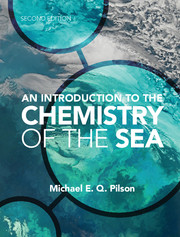Book contents
- Frontmatter
- Contents
- Preface
- Acknowledgments
- 1 Introduction
- 2 The water in seawater
- 3 Salinity, chlorinity, conductivity, and density
- 4 Major constituents of seawater
- 5 Simple gases
- 6 Salts in solution
- 7 Carbon dioxide
- 8 Nutrients
- 9 Trace metals and other minor elements
- 10 Radioactive clocks
- 11 Organic matter in the sea
- 12 Anoxic marine environments
- 13 Exchanges at the boundaries
- 14 Chemical extraction of useful substances from the sea
- 15 Geochemical history of the oceans
- Appendix A The chemical elements
- Appendix B Symbols, units, and nomenclature
- Appendix C Physical properties of seawater
- Appendix D Gases
- Appendix E Carbon dioxide
- Appendix F Dissociation constants and pH scales
- Appendix G Solubility of calcium carbonate
- Appendix H Effects of pressure
- Appendix I Radioactive decay
- Appendix J Geochemical reservoirs, and some rates
- Appendix K Sound absorption
- Epilogue
- Questions for chapters
- Glossary
- References
- Index
- Miscellaneous end matter
Appendix F - Dissociation constants and pH scales
Published online by Cambridge University Press: 05 February 2013
- Frontmatter
- Contents
- Preface
- Acknowledgments
- 1 Introduction
- 2 The water in seawater
- 3 Salinity, chlorinity, conductivity, and density
- 4 Major constituents of seawater
- 5 Simple gases
- 6 Salts in solution
- 7 Carbon dioxide
- 8 Nutrients
- 9 Trace metals and other minor elements
- 10 Radioactive clocks
- 11 Organic matter in the sea
- 12 Anoxic marine environments
- 13 Exchanges at the boundaries
- 14 Chemical extraction of useful substances from the sea
- 15 Geochemical history of the oceans
- Appendix A The chemical elements
- Appendix B Symbols, units, and nomenclature
- Appendix C Physical properties of seawater
- Appendix D Gases
- Appendix E Carbon dioxide
- Appendix F Dissociation constants and pH scales
- Appendix G Solubility of calcium carbonate
- Appendix H Effects of pressure
- Appendix I Radioactive decay
- Appendix J Geochemical reservoirs, and some rates
- Appendix K Sound absorption
- Epilogue
- Questions for chapters
- Glossary
- References
- Index
- Miscellaneous end matter
Summary
The choice of a suitable pH scale for the measurement of oceanic pH remains for many people a confused and mysterious topic.
DICKSON 1993One of the more confusing aspects of the recent literature of marine chemistry concerns the development and elaboration of the necessary dissociation constants for the many substances in seawater that associate with or release a hydrogen ion (carbonate, sulfate, phosphate, borate, etc.). Investigators in this field have used three different concentration scales for the reactants: mole per kilogram of water scale (molality); the mole per liter scale (molarity) identified by the symbol M; or a mole per kilogram of solution scale (if the solution is seawater, it is the seawater scale, sometimes called molinity). This last concentration scale is now generally universal for measurements in open ocean waters.
There are several different pH scales proposed or in use for describing the concentration or activity of the hydrogen ion in solution. Authors have not always been entirely explicit about the conventions used, and different symbols or descriptors have sometimes been used for the same convention. Caution is advised when reading the literature.
- Type
- Chapter
- Information
- An Introduction to the Chemistry of the Sea , pp. 441 - 449Publisher: Cambridge University PressPrint publication year: 2012
- 1
- Cited by

